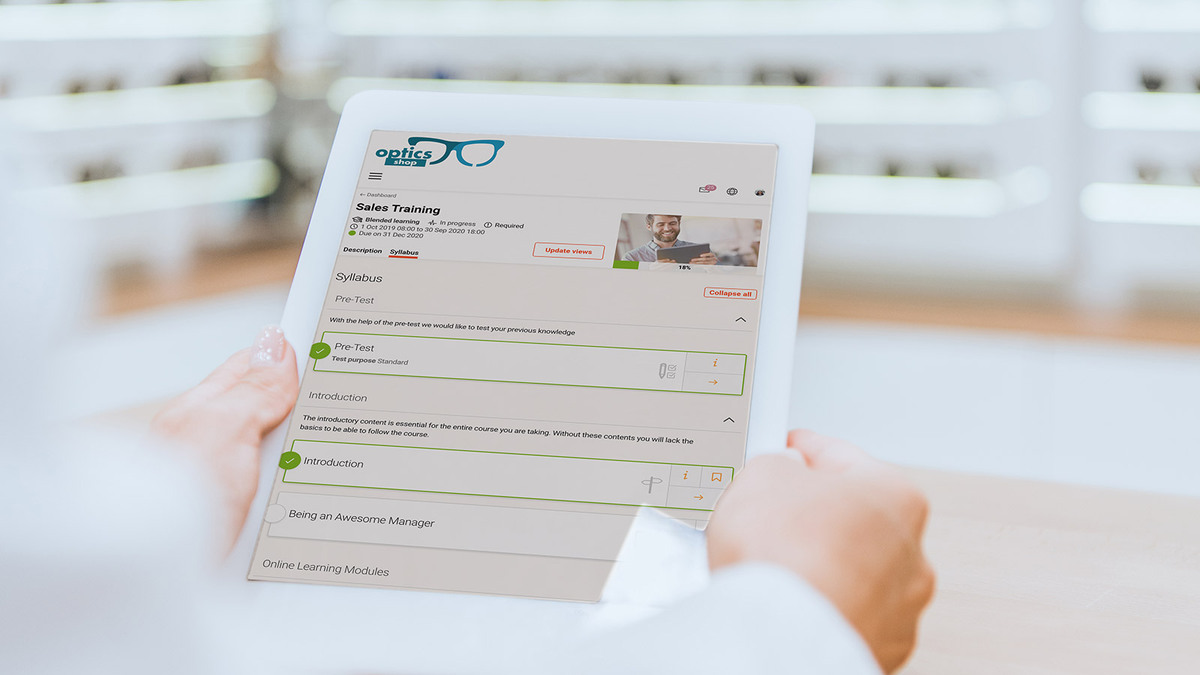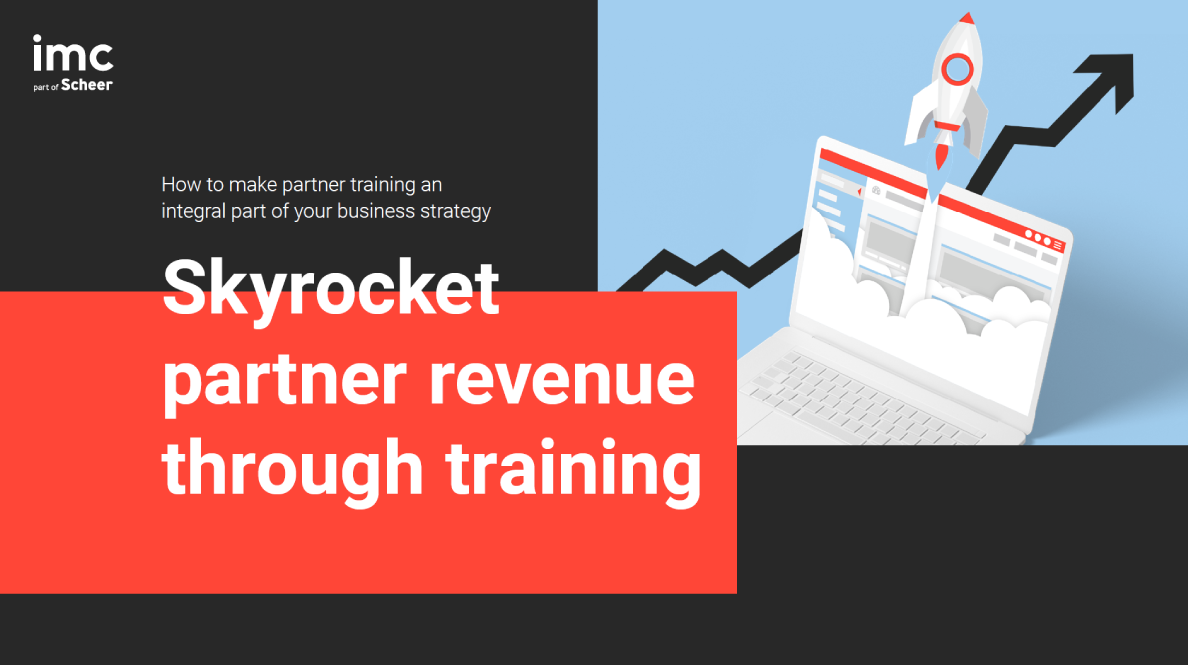
On the podium thanks to e-learning: why sports clubs and associations should focus on digitalisation
After the Olympics is before the next Rugby League, is before the FIFA World Cup! Or vice versa. Regardless of discipline: Training is not only essential for the professional athletes and players, but their trainers, referees and crew members also need continuous professional development.
Summertime is Sports Time! But no matter if watching Tennis, Rugby or Athletics: physical effort and mental training is not the only one. Behind every successful athlete is an entire association and a team that also needs to train and continue learning.
This ranges from new training methods through first aid courses to preventive approaches and anti-doping training – and everything in between. We spoke to a former pro athlete, and explain how these and other topics can be presented as e-learning contents, and what advantages that brings.

Going for gold with blended learning

Eric Uder
Clubs and associations increasingly facilitate continuous development through e-learning, as imc Solution Consultant and former professional javelin thrower Eric Uder notes: “The associations need to ensure that training courses on new training methods, referee rulebooks and preventive approaches are carried out and understood.
Pure face-to-face training is not always helpful in this context. Rather, more and more sports associations from a vast range of disciplines favour blended training concepts, combining e-learning with on-site training.”
No chance for a second Wembley goal
According to Uder, sports associations utilising e-learning is nothing new in itself. After all, the integration of the digital and analogue world has long arrived in sports. That also includes using goal-line technology in football to verify precisely whether or not the ball was in. We can therefore rest assured that we won’t see another Wembley goal.
Moving training scenarios from a face-to-face format to an online environment is thus an obvious solution. Even associations which long resisted this step are now coming around to it, as Uder explains: “We have been supporting larger associations from New Zealand and Australia for years; for instance, in rugby. We now see that the German associations too are increasingly interested in online training concepts and our platform.”

New training scenarios tap into new target groups
With the introduction of a learning platform or learning management system, associations open up far more opportunities than simply training the trainers and referees: Volunteers can gain access and complete mandatory training courses or inductions online, at any time and from anywhere.
It is also easy to include sponsors, keep them informed and offer them insights into current affairs, new regulations, and other items of interest. The possibilities are endless. All types of content can be accessed smoothly without jumping through hoops: from video tutorials, through web-based training to learning nuggets, from compliance through anti-doping to mental health topics.

Excuses are so yesterday
Uder predicts: “I believe that sports associations will place an even stronger focus on digital learning platforms in coming years. They are facing enormous challenges: On the one hand, they are expected to produce results. On the other hand, they are often short staffed and lack financial resources. This makes healthy budgeting practices even more important.
An LMS allows them to send out automated reminders for training courses, book entire groups of members onto new courses at once, or integrate tests to verify that participants have understood the contents. This all saves time while enhancing transparency. It makes it easy to verify who completed which training course when.”
This may well be the knockout punch for excuses claiming ignorance on rules. Maybe, it will even allow us to experience what we crave the most: Sports successes the entire team, as well as the associations and fans can celebrate without reservation.

Don't call it compliance!
Compliance training - the term alone is a red flag for many employees. We give some tips how to create an interesting training instead.

Why the gains from an LMS outweigh its costs
A Learning Management is far too expensive? Not if you use it in the right way! Even more: For most clients, an LMS pays for itself within a year. We tell you how to prove that with a Business Case.
Contact person
I have been working in the Marketing & Communication Team at imc since March 2019.
Communication, creative content and social media are my passion. "KISS - Keep it short and simple" is my credo.
To explain complex content in an understandable way and thus make the topic of e-Learning accessible to everyone is an exciting challenge every day.
Privately I love to read, play poker and travel a lot.
I am always happy to receive feedback or suggestions.

Why companies cannot afford to skip training their external partners
Only considering your own workforce when planning your training is short-sighted. After all, distributors, franchisees, agents, brokers, as well as association members and even volunteers contribute to corporate success just like your in-house employees.
Consequently, these external partners need to know all the details of your company’s products and services. In this article, our experts show how to set online training up for success in such an extended enterprise learning scenario, and how to turn a learning curve into an earning curve.
Revenue losses through deficient distributor and network partner training
To understand “partner training” let’s picture the following scenario: A manufacturer of glasses and other optical aids is launching new contact lenses that are particularly thin and suitable for sensitive eyes. First of all, the company’s own sales staff need to know the benefits of these contact lenses, as they sell the products either directly to the customers or to other companies like Company B.
If the products are sold on via a trading partner as an additional distribution channel, the sales consultants employed by Company B also need to know the particularities of the new lenses. The crux: You can only sell a product if you know its benefits. This holds true even more when a trading partner sells products from more than one provider and has several suppliers.

NOTE
Distributors, trading partners AND external sales people all have the same need for specialist and product knowledge. Leaving out this target group when arranging learning and development measures is a missed opportunity for significant revenue growth.
Which target group should an extended enterprise training scenario take into account?
The circle of distribution partners includes more than just external sales employees. Depending on the sector and the orientation towards B2B or B2C business, a completely different set of target groups should be addressed and included. For example:
- Distributors and dealers (car dealerships, opticians)
- Franchisees (restaurants, insurance companies, real estate agents, etc.)
- Specialist staff in the insurance, health or medical technology sectors
- Joint ventures
- Partners
- Customers
- Members and voluntary staff
- Friends and family
- The general public

Sales training for external partners: online or in person?
Once the external partner network has been defined, the question is: Is it better to train these employees online or in person? Both options have advantages and disadvantages which need to be balanced precisely. The idea to present such distributor training online – for instance, in a learning management system (LMS) – is not new.
The benefits are obvious: Instead of sales consultants travelling to attend on-site training, all employees ultimately involved in selling the product can complete relevant product training in the convenience of their home or their workplace using various devices. For instance, an optics manufacturer placing their products with various chains can provide remote access to the product training to all sales staff of those chains’ branches.
However, the drawback of such online training is that employees are often under time pressure or lack motivation to get started with such training. It is therefore crucial to minimise any barriers to entry for training measures.
For instance, complicated registration processes act as a deterrent. Combined online and face-to-face training within a hybrid learning concept or even a true blended learning scenario may also be suitable options.
Having assisted numerous imc customers with the development and support of such training, training expert Anika Rabe recommends:

Anika Rabe
“Most of the time, product training is not designed for the general public and must therefore be set in a secure area. An LMS is a suitable option for this.
Yet, the training courses must be easily accessible for everyone and, above all, they must be interesting. In particular, external employees must be involved on an emotional level rather than stopping at technical product knowledge.”

Facts tell, stories sell
No emotion – no sales. Especially when technical differences between products or brands have no major impact, brand loyalty and great storytelling are key.
An external employee needs at least the same degree of emotional investment as a team member of the manufacturer - they must both convey enthusiasm for the product. That is exactly what product training needs to deliver. Items like smartphones, jewellery or cars are frequently bought for emotional reasons, rather than based on mere facts.
If a sales consultant can share their enthusiasm for a product, customers are more likely to buy it – even if, objectively, it is not better or cheaper.

One size fits all is a thing of the past
The training that helps external partners internalise these stories differs from that most helpful to your own employees. Internal team members already have a special connection to the brand or the products. They already believe in the quality standard, and need not be won over.
This is an important aspect to take into account. One-size-fits-all solutions no longer have a place in training design – and even the best training will fail if it is unnecessarily difficult to access. This is why training expert Anika Rabe recommends: “Making it easier to access learning means making it more likely for the learning experience to be shared by everyone. For example, adding a QR code to products that are new or involve a steep learning curve is easy, and can be used to direct the user to the relevant training course with a simple scan.”
However, Anika notes that simplified access also makes it harder to verify training. If a training course requires no prior authentication, the creator of the learning content cannot know with certainty whether the end user really completed it, nor how much time they invested. It also remains unknown how much the learner actually learned, and whether they actively apply that knowledge.
Yet such assessment is important, especially when optimising and evaluating learning content. While in-depth learning analytics would be taking things too far in this context, it is a topic L&D managers should keep an eye on.
Combining both worlds to boost sales
According to Dr. Wolfram Jost, Board Member and Head of Product Management at imc, the only thing that really matters in the end is this: The learning curve must be transformed into an earning curve. No company trains employees just for fun – whether that is internal employees or external partners. Especially in the extended enterprise learningscenario, the fundamental objective is to increase the company’s sales. Partner training must contribute to corporate success.
It helps to keep these key questions in mind when designing your extended enterprise training to transform the learning outcome into revenue.
- Objective: What is the training designed to achieve?
- Target group: Who is meant to be trained? What prior knowledge does my target group have? What information and which stories do they need?
- Conceptual design: What type or combination of training is suitable?
- Performance assessment: How do I define success? How and when do I measure it?
- Training access: How can I simplify training access?
- Learner motivation: How can my training design ensure that external partners enjoy the training process and retain the learned content?

Onboarding, slightly different
Onboarding can already be integrated into an existing LMS, but this benefit is hardly ever used.
We took a little trip into the (near) future to see what a successful onboarding process could look like.

Why the gains from an LMS outweigh its costs
A Learning Management System too expensive? Not if you use it in the right way! For most clients, an LMS pays for itself within a year. We tell you how to prove that with a Business Case.

More about our LMS
If you would like to learn more about imc's Learning Management System, check here for more information.

Contact person
I have been working in the Marketing & Communication Team at imc since March 2019.
Communication, creative content and social media are my passion. "KISS - Keep it short and simple" is my credo.
To explain complex content in an understandable way and thus make the topic of e-Learning accessible to everyone is an exciting challenge every day.
Privately I love to read, play poker and travel a lot.
I am always happy to receive feedback or suggestions.

Never file folders again!
How a validatable LMS significantly saves on time and paper
An interview with a representative from the medical technology industry
There will always be challenges to face when converting or introducing a Learning Management System (LMS). However, it becomes even more difficult if the learning platform also needs to map validatable processes. This is a particularly important issue in the medical, pharmaceutical and medical technology industries, as work processes and training courses must be fully documented. We spoke with a representative from the medical devices industry who recently made this type of changeover.

Hans-Heiko Müller, Team Manager for Organisational Learning at pfm medical ag
Hans-Heiko Müller works for pfm medical ag, an internationally operating medium-sized family business from Germany that offers special solutions in the healthcare sector. As Team Manager for Organisational Learning, he is responsible for the documentation of internal training and professional development.
He had already been working with imc's LMS and the imc Learning Suite since 2014 and initiated and oversaw the company's conversion to a validatable system. In this interview, he tells us how the conversion went, what challenges he and his team faced, and how many metres of DIN-A4 folders he now saves.
INFO
The term validation or validation obligation means that detailed evidence that a technical process has complied with requirements must be documented. Simply stated, the aim is to assure the quality of a product in order to prevent serious errors. This is extremely important for eliminating the endangerment of patients in high-risk industries such as the pharmaceutical industry and the manufacture of medical devices.

Hello Mr Müller, please tell us: What do validation processes and learning management systems have to do with each other?
The European Medical Device Regulation MDR and the U.S. Food and Drug Administration FDA impose very strict requirements for this. These requirements state that, if a computer-aided system is integrated into a quality-relevant manufacturing process, documented evidence of this must be provided.
This evidence must show that the system meets the requirements and will perform exactly as specified, both now and in the future. In other words, the system, or in our case the LMS, must be verifiable at all times, and every process must be clearly traceable. This applies, for example, to any changes made to training materials.
At pfm medical, you decided to take the step towards a validatable LMS in mid-2020; how did this come about?
There were several reasons. For one thing, we have to meet the legal requirements, and the European Medical Device Regulation, which was enacted in 2017 and is mandatory as of May 2021, included some innovations that had to be implemented.
Another consideration was the fact that, generally speaking, documentation prior to validation was very time-consuming. We had to carry out a great many procedures manually.

How can I picture this manual documentation?
Basically, all employees must complete certain training courses, for example professional development courses on the individual products. Depending on the type of training, it may need to be repeated or renewed on a regular basis.
Before the conversion, the documentation worked like this: We manually enrolled an employee in the course, and they were able to complete it either online in the LMS or in person. Afterwards, they had to print out a certificate showing that they had taken the test, acknowledge this with their signature and either submit the slip in person or send it by post.
After receiving the letter, we had to check whether the employee was really enrolled on this course and confirm their participation manually in the system. Because we are required to keep these records by law, and in some cases for decades, we manually filed the supporting documents in paper folders.
This added up to about ten running metres of DIN A4 folders within two years. My colleague and I spent several hours each week comparing and categorising. This standard procedure, which is the order of the day in many companies in the medical technology sector, ties up a lot of resources.
That sounds very cumbersome indeed. What does this process look like now with a validatable LMS?
All employees are assigned to different groups, and I can book these groups in specific training courses and onto specific learning paths. The additional professional development courses that are relevant for validation are also found there.
Let's take the example of medical device consultants who have to instruct doctors on our products. If I specify that the group with all consultants must attend a training course on the latest products every year, the system automatically books the entire group into the appropriate training courses. I can also set automated reminders (called escalation management) in the system. This will send a reminder to those who have not completed the training course by a certain time.
Once the employees have completed the course, they can log it directly into the system. To do this, they have to be logged in with their user name and password and also confirm their participation with their electronic signature (e-signature). That's it. We can then see when the employee has completed the training course, and the certificate is stored in the system. We don't have to print anything out or file anything extra.

Can you give us some insights into what was important to you when selecting a vendor?
We not only wanted support with the conversion of the system, but also help with the documentation going forward, because with every update, with every small change I make in the LMS, the potential impact of the change has to be documented. This is extremely time-consuming, and each update quickly adds up to 100 pages.
Theoretically, we could also do this work ourselves, in other words, run through all the scenarios completely and document them. However, I would need to hire at least one full-time employee to do this. We wanted a "comprehensive, worry-free package" that would not only cover the issue of security, but also make our work considerably easier.
What was the actual conversion process like?
First, we worked with imc to create a requirements analysis of the company's learning processes. This involves such aspects as the organisational structure and the structure of the learning content or learning processes. This was followed by the reconciliation of validation documents and the provision of user requirements and functional requirements including risk analysis.
Then, in the planning phase, we were provided with a development system (DEV system) for initial workshops. In the workshops, for example, the administrators were trained, and we set the system up and used it on a test basis together. In the third phase, a test system, or STAGE system, was put into production, and this in turn was tested. This was followed by the deployment of the productive system.
The process took just under four months altogether. If we had done it completely on our own, it would have taken us an estimated 18 to 24 months.
Did you have any fears or anxieties about the conversion beforehand? How did you deal with them?
Of course, we had respect for a project of this magnitude. But we saw the conversion as an opportunity to bring the old world into the digital age. For example, we took another look at all the processes and checked to see where they could be streamlined.
As a result, we now have training processes that are uniform for all employees, including those of our subsidiaries. There was a real change in culture which was also initiated by the fact that we worked with so many different departments.
At the same time, this presented a certain challenge, in that we first had to find out which "language" everyone spoke. Terms such as system or DEV system can be interpreted differently by each department. For example, since we worked with HR as well as IT, it was immensely important to make sure that everyone knew what was meant by which term. Clear agreements and a regular exchange are essential for this.
Were there any other challenges?
Personally, I didn't find it easy to relinquish some of the responsibility and rely on an outside vendor, because as I mentioned, I had already been working with the LMS since 2014, knew how it worked, and could make changes myself.
During the conversion, however, it was the provider, and not I who worked on the system. In a way, that was a leap of faith, because I didn't know exactly what was going on in the background. It made me a little nervous at first. However, we agreed on short sprints, in other words, weekly coordination meetings with the possibility of readjustments, so that I was reassured and could follow where we were in the process at any time.
However, you should be aware that you lose some flexibility with this sort of system. Changes that I could previously make myself with a check mark are now locked and have to go through a change process which has to be applied for, checked within the context of a four-eyes-principle and documented before it can be implemented. This strict process ensures the prescribed safety, but the price is less flexibility. Still, the advantages clearly outweigh the disadvantages for pfm medical.

What would you recommend to companies facing the decision to have their system changed?
My advice: You have to take a careful look at the processes in advance and then have the courage to adapt them to the technology. Not the other way around. This way you can be sure that there will be no problems during audits.
Thank you so much for all your insights!
Further information
Curious to find out more about pfm medical's validatable LMS? Then check our reference page.
Or download the whitepaper about how to master validation with an LMS.
Not enough? Then watch the webinar recording with Hans-Heiko Müller related to the topic validation in a LMS (German only).

How not to break bad with validated processes in an LMS
What requirements must an LMS map for validated processes? And how does Breaking Bad fit here? Questions about questions not only the Pharmaceutical industry should think about.

Learning Analytics: It comes down to the right questions
Learning must not be an end in itself, but fit in the company’s business outcome: More and more managers are demanding this. We therefore looked at how L&D managers can meet this requirement with the help of Learning Analytics.

More about our LMS
If you would like to learn more about imc's Learning Management System, check here for more information.

Contact person
I have been working in the Marketing & Communication Team at imc since March 2019.
Communication, creative content and social media are my passion. "KISS - Keep it short and simple" is my credo.
To explain complex content in an understandable way and thus make the topic of e-Learning accessible to everyone is an exciting challenge every day.
Privately I love to read, play poker and travel a lot.
I am always happy to receive feedback or suggestions.

learning culture
When the Act of Learning Becomes a Habit
Organisations that can readily adapt and change are the one's that succeed. Those who look beyond using learning for compliance are reaping the benefits.
A featured article in The Australian Financial Review
Researcher Imed Bouchrika, writing on research portal Guide2Research, says training has become an integral part of workforce development, employee performance and organisational competitiveness, noting that “intellectual capital is valued just as much as physical and financial assets”.
“Training and development is most effective when implemented strategically, which involves content development, method of delivery and integration of technology,” Bouchrika writes.
To remain competitive, continuous learning has become imperative in creating and maintaining a sustainable advantage.

imc's featured article as printed in the Australian Financial Review
Nick Petch, head of learning experience design and strategy at imc Australia, says a “big shift” is needed in organisations’ approach to learning and development.
“For many organisations, the core skills and competencies that drive their organisations have shifted and changed almost overnight. Overcoming these challenges means radically changing the way learning and development occurs,” he says.

Reaching Business Growth by Learning & Development
Bringing all parts of digital learning together will increase revenue, improve efficiencies and organisational growth.

Redefining Your Organisation’s Learning and Development Strategy
The digital transformation of learning is having an immediate and notable impact on business performance. The dominant behaviours that will define success are adaptability, nimbleness and alignment.
Contact


Multi-tenancy LMS solutions
Here we look at multi-tenancy LMS solutions, including a definition, the types of organisations that leverage them, and how imc can help clients to maximise their effectiveness to deliver training across diverse groups of learners.
What is multi-tenancy?
In the field of software, the term multi-tenancy refers to a single application shared by multiple user groups who each experience their own, individualised working environment.
Each ‘tenant’ is a group of users that shares certain common features with other tenants, but that may have certain design elements, layouts and privileges that are unique to their group.
A useful analogy is a block of flats. The building has a shared entrance, lifts and stairways, but each tenant has their own, self-contained flat. The tenant can choose their own appliances, furniture and interior design / decor.
What is a multi-tenancy LMS?
A multi-tenancy LMS is a single learning management system instance that serves various learner groups with differing training needs. This may take a range of potential forms, depending on your organisational needs, and could include:
- Different departments across a large organisation - for example, you may have separate learning environments for Sales and Manufacturing teams because their training needs are so different
- Local offices across different locations - even multiple countries, allowing localisation or translation of training content
- External partners - you can create tailored learning platforms for groups outside your own organisation, including suppliers, distributors and channel sales partners. This type of partner training is known as Extended Enterprise Learning.
- A specialist training company, delivering any number of client-branded learning environments, or even using ecommerce to sell courses online.
Your organisation-wide L&D team can control what content and features are rolled out to all tenants, and what is managed within each individual group.

Benefits of a multi-tenant LMS
The benefits of multi-tenant LMS vs a standard learning platform are numerous, but the overarching themes are efficiency and flexibility. Here are some of the elements that L&D managers and business leaders are looking to achieve when they choose multi-tenancy:
Cost reduction
When you need to segment the learning experience across departments, it has been common in the past for each one to have their own LMS. A multi-tenancy LMS offers economies of scale and allows each department to share the cost of the core platform and any common content, features, and system upgrades.
Knowledge and resource sharing
When every department operates in completely distinct silos, there is less functionality and visibility between them to facilitate resource and knowledge sharing. If something works for / is created within one department, a multi-tenant LMS makes it easy for the central administration team to share it across more or all departments.
Departmental and centralised analytics
With multi-tenancy, you can drill into course and learner analytics at the departmental and group-wide level. This can help you to identify and address training needs and weaknesses among certain types of user. It also helps you avoid overall learner data getting skewed by one or two outlier groups.
Speed of implementation
When something changes that affects several or all of your teams, it can be much faster to roll out from central management if they can influence all of those learning management systems in one hit.
For example, new legislation like GDPR could affect all departments, so managing relevant training from a central location, while allowing it to be customised if and where needed, can greatly quicken roll out.
Brandability
Whatever the training needs of a certain learner cohort, a multi-brand LMS enables each group to make their LMS feel like home.
Whether it’s for external clients to have their own company branding or internal teams who just want to customise it to their preferred style, a branded LMS can enhance user acceptance and in turn, improve compliance, engagement and learning outcomes.

Why an imc learning management system?
Founded in Germany, imc is one of the world’s leading elearning and LMS providers, with offices and clients across the globe. With a diverse, international presence, we understand the needs of companies that need to train dispersed and diverse audiences. We combine some of the sharpest technology minds with deep experience within L&D.
imc is trusted by well-known brands, including Vodafone, Deloitte, Sky, Daimler, BASF and many more to deliver on their elearning needs.
Many of our clients benefit from our ability to create and deliver powerful multi-tenancy solutions that work equally well in multiple languages, offline or online, on desktop or mobile.
With a huge, unique array of integrations made possible via APIs, we can help you to create a learning ecosystem that plays nicely with your existing training, HR, sales and other business systems. This allows you to plug seamlessly into 3rd party tools like Workday, Adobe, SAP, YouTube, Salesforce, and even ecommerce gateways like PayPal and Shopify if you want to sell elearning courses.
Whatever your internal staff or external partner training needs, imc can help you to create a multi-tenancy LMS solution to power your current and future learning.

How to train external audiences
It’s no secret that your internal team is your organisation’s greatest asset. However, you should bear in mind that it isn’t your only asset.

Business growth through L&D
Data suggests that when organisations spend USD 1,500 per employee per year on learning, they achieve improvements in profit margins of around 24%.
Contact
As imc has over 20 years of experience working with 1,200+ organisations globally, we can confidently say we have seen and solved many business challenges just like the ones you are facing today.
That’s why we would love to learn more about your situation and to give you some tailored, expert advice to solve the obstacles that you are facing.
Feel free to connect with Tracey for a free consultation call.


Growing your business through partner training
It’s no secret that your internal team is your organisation’s greatest asset. However, you should bear in mind that it isn’t your only asset.
An organisation doesn’t operate in isolation. Its growth and success are also dependant on its network of partner relationships.
Your partners’ success is your success and in order for your partners to be successful, it’s your job to support them in every way you can. Training plays a pivotal role in this. If your organisation trains its network of partners, you empower the people outside of your organisation to contribute to your business goals.
It results in:
- more trained resources
- more efficient collaborative processes
- more revenue
Plus, it turns your partners into advocates and your advocates into your most ardent sales representatives.
In short, it will grow your business.

A massive opportunity, especially now
In these unprecedented times, many organisations are cautious when it comes to future plans. However, many others use this moment to accelerate their organisation’s digital transition and see new business opportunities.
“With massive disruption comes massive opportunity. I've seen many organisations rethinking their business model, with digital learning becoming an enabler to help them extend reach, drive new channels or implement new business approaches”, says Russell Donders, imc’s Director of International Markets. “(Digital) partner training is definitely one of these opportunities to grow businesses in challenging times.”
Partner training in an extended enterprise
The approach of empowering partners through training, is often referred to as Partner Training or Extended Enterprise Training.
But what is an extended enterprise?
An extended enterprise acknowledges that its growth and success is (partly) dependant on its network of partners. Therefore, it invests in its partner relationships and strives for optimal communication and collaboration with these partners, ultimately, to achieve shared business goals.
Aligning and training are essential in leveraging the collaborative relationship of all the partners involved in this extended enterprise.
And that is not just sales partners. Customers, members or even the general public can also be valuable partners who can contribute to your business goals. Keep that in mind when we are talking about partners; among all those external audiences connected to your organisation, there might be more potential partners than you think.
Competitive advantage
As most organisations fail to effectively empower external audiences, partner training (or extended enterprise training) will create a strong competitive advantage in your target market.
Ultimately, unlocking all that extra market potential will result in increased earning potential.
Or as our imc board member, Wolfram Jost, puts it: “a learning curve leads to an earning curve.”

Wolfram Jost, imc board member
What about not-for-profit organisations?
The concept of an extended enterprise sounds perfect for businesses, but what about not-for-profit organisations? Such entities often don’t see themselves as businesses or any form of commercial enterprise, for that matter.
Thankfully, the principles and ideas of extended enterprises for commercial entities also work well for non-profit organisations.
Remember that the word ‘partner’ can refer to all kinds of external audiences. If you run a not-for-profit organisation, the extended enterprise concept and the idea of training the partner network can also apply to e.g. your members or volunteers. Educating those external audiences will help your not-for-profit organisation achieve its goals, even if these goals are not primarily commercial.
How to get started with partner training
The concept of partner training sounds good in theory. But, how does it work in practice?
You may be worried about the logistics, the complexity or data security, data privacy, and compliance. All these thoughts conjure up many red flags in your mind and cause alarm bells to ring.
In other words, the mere thought of partner training is causing you to break out in a sweat.
But what if setting up a training environment that caters to all your needs isn’t as complicated or scary as it sounds?
The most important takeaway is: do not try to reinvent the wheel.
This is how you make partner training an integral part of your business strategy

In our whitepaper Skyrocket partner revenue through training we discuss the topics you should consider when incorporating partner training in your business strategy and we share practical tips and insights about how to get started.
Contact
As imc has over 20 years of experience working with 1,200+ organisations globally, we can confidently say we have seen and solved many business challenges just like the ones you are facing today.
That’s why we would love to learn more about your situation and to give you some tailored, expert advice to solve the obstacles that you are facing.
Feel free to connect with Ailbhe for a free consultation call.


Shaping the new world of Corporate Learning in 2021
Our series of articles from imc employees all over the world started in Switzerland. In this episode we take you to the other side of the world. Daniel Antman, Director imc Australia, has joined imc in February 2020 and had to face special challenges right from the start. In this guest article he talks about his experiences, lessons learned but also chances and possibilities for the Australian e-learning marketing in 2021.

Daniel Antman, imc
The digital transformation of learning is having an immediate and notable impact on business performance. Companies will need to redefine their organisation’s learning and development strategy in 2021 to ensure alignment with their revenue and growth objectives.
As we approach the end of what can only be described as a tumultuous 2020 and look forward to 2021, the dominant behaviours that will define success are adaptability, nimbleness and alignment.
Many businesses are going through their 2021 strategic planning right now and some who may have already completed their plans, are going back to revisit them to ensure they are relevant to the probable long-term structural changes we have seen.
From a macro perspective we see a relatively stable outlook for both Australia and New Zealand. We have a well-capitalised banking sector that has proven its resilience in throughout both the global financial crisis and more recently through the pandemic.
At the national levels both economies have relatively low debt levels to GDP (compared to other western economies) ensuring there are tools in the fiscal cabinet for government (Federal and State) to implement stimulus programs to keep the economy moving. We have unprecedented low interest rates that have kept both consumer spending and the housing market at acceptable levels throughout this 2020 Covid impacted year.
We have also not yet seen the expected spike in unemployment. While the expectation is that the peak in unemployment won’t be seen until Q1 2021, there is a quite confidence it may not be as bad as originally predicted. The jobkeeper program (a federal government initiative that has ensured workers impacted by a shut-down in their sectors retain an income) has steadied the economic ship and minimised the impacts of the covid shut-downs.
Perversely we think there may be upside in the dislocation of people from their traditional jobs and professions as they potentially return to the workforce in different industries. The movement of people into new roles and businesses should in theory bring into focus the need for more and effective training.
We have seen a significant uptick in employment with some of our clients in the public sector who have absorbed a number of displaced workers. For example, we have seen a consistent increase in demand for our content services from DHHS (Department of Health & Human Services) who have been actively expanding throughout the covid crisis.
There is also a sense the language of business is changing. A few months ago people in business were still saying “when things go back to normal we’ll do this and that”. Now the rhetoric is changing.
There is greater recognition, at least empirical recognition, that we are probably going to be forever spinning on a new axis. Think back to the 2011 powerful earthquake that moved the main island of Japan by 8 feet and shifted the Earth on its axis. It’s where we are at in terms of the business landscape too – spinning in a different place and probably never going back.
We also rethinking the way businesses are segmented in Australia/New Zealand corporate market. While businesses can be easily bucketed into defined categories, for example financial services or utilities, from a learning perspective we see them grouped differently. Specifically, we see the local corporate landscape being defined as entities that are:
- Membership orientated (e.g professional associations like ACCA and AusIMM)
- Exposed (e.g those heavily impacted by regulation/compliance like financial institutions)
- Complex (e.g dynamic entities who requires a deep and complex solutions that brings their organisation together like a pharma business)
- Challenged (e.g Organisations who have experienced significant and complex growth pains and have been forced to evolve due to late adoption)
- Branded (e.g Organisations who have a brand promise to uphold and deliver like Blackmores)
It is true that an entity may take on more than one of the above characteristics yet they typically have a bias to one. The importance of understanding this in the Australian context is that learning and development will mean different things to entities where there are different bias’s. That requires our communication, business development and marketing to be bespoke and identifiable to them.
Within each of these business personas are the decision makers and, when it comes to aligning the concept of learning with business objectives, they will be motivated by different things. While these are not new concepts (in terms of how decision makers can be categorised), we are seeing the emergence of clearer definitions of who the decision makers are in the types of organisations noted above.
In other words, it’s a bit of a match-and-mix matrix between the type of organisation and the decision makers. As the concept of employee development, training and motivation in a remote working environment continues to unfold, decision makers will need to be swayed by targeted and relevant messaging about the role of learning and how the empowerment of their people is directly connected to business performance.
These decision makers can be broadly classified as one of:
The Charismatic - decision makers with big ideas and proven results that speak to the bottom line and keep my company competitive.
The Thinker - Intelligent, low-risk solutions that save time and money.
The Sceptical - Ground-breaking ideas with people I can trust.
The Follower - The best ideas have been tried and tested by big brands.
The Controlling - Highly structured arguments that fit like a glove.
Adaptability and Speed Are Key

We’ve seen many examples of businesses having to adapt to this new business as ‘unusual’ environment. In a learning context, we’ve seen companies pivoting from delivering in-house training sessions, offsite sales conventions and other forms of in-person professional development to a full digital delivery format.
Those who have adapted quickly may well be best positioned to capitalise on the ongoing benefits of digital learning. It’s one thing to adapt, it’s another thing to do it efficiently and effectively. Again, in a learning context, those businesses who have been fast and adept at embracing new delivery mediums are having more success in maintaining effective connections with staff and key stakeholders.
Aligning Learning Strategy to The Digital Generation
Aligning the delivery of quick, effective and meaningful knowledge-transfer with the commercial/performance imperatives of the business has never been more critical. For many astute business people, the current climate has highlighted the critical importance of knowledge transfer and learning to drive increased engagement with staff and other stakeholders including customers.

Stable, well trained and stimulated employees translate directly to the bottom line. Well-developed and informed customers/stakeholders become advocates for businesses.
A recent LinkedIn research study identified the primary driver that connected Millennials and Gen Zs to the organisations they worked for was development. Not pay or work conditions, but development.
For organisations who see themselves as genuine learning businesses, and who are committed to developing and growing their teams, their time has come. They are embracing the technologies that will enable them to deliver the learning that is valued by those seeking the development, support and care.
Happy, stimulated, developing and supported employees are those more likely to stay and contribute to ongoing success - something every C-Suite and/or senior manager needs to keep in mind.
Virtual Conferencing Tools and Learning

Throughout the crisis of 2020 businesses have turned to and utilised connectivity tools including Zoom, GoToMeeting and Teams to mention a few. In many respects these tools have been a communication lifeline for business. Yet on their own they are not learning, training or development tools.
Genuine learning that is impactful, sustainable and measurable needs to be expertly designed to ensure it delivers the desired outcomes through the chosen delivery platform. Virtual conferencing tools can and often do play an important part in a blended learning environment. However, they are not designed to be alternatives to expertly designed and delivered learning platforms.
Would You Like Cake & Coffee with Your Training?
Are those days gone? No longer can businesses rely on the attraction of food and drink to encourage staff to join the in-house training sessions in the communal meeting rooms. Nor can they rely on trips to the local café which doubled up as the overflow meeting room when the office facilities were booked.

Yet the challenges that 2020 have thrown out open the opportunity for innovation and out-of-the-box thinking when it comes to learning. The sophistication and power of technology driven learning platforms offer businesses with exciting possibilities to deliver knowledge in a way that can be a genuine game-changer.
Learning, training and knowledge-transfer are no longer the sole domain of the HR or Learning Development teams. They should be a focal point for the C-suite and boards when considering how to leverage digital learning platforms to develop, stimulate and ultimately retain the people they rely on to meet their business objectives.
Contact
I’ve been a member of the imc crew since February 2019. My multi-faceted tasks always keep me on the go. In addition to my work on corporate brand, marketing and communication strategies and employer branding, I also delve into the operational side.
I have a passion for networks and communities. That is why I represent the brand ambassador programme in the editorial team. I am also actively involved in the SCHULEWIRTSCHAFT (School-Business) network.
Privately, my big passions are travelling, Disney and interior design.

Impactful Learning: The Driving Force Behind Business Performance
The digital transformation of learning is having an immediate and notable impact on business performance. Those who have adapted are reaping the rewards, says Daniel Antman, Managing Director of imc Australia. In his opinion, companies will need to redefine their organisation’s learning and development strategy in 2021. A personal statement.

Daniel Antman, imc
As we approach the end of what can only be described as a tumultuous 2020 and look forward to 2021, the dominant behaviours that will define success are adaptability, nimbleness and alignment.
Many businesses are going through their 2021 strategic planning right now. And, some who may have already completed their plans are going back to revisit them, to ensure they are relevant to the changed and the probable long-term structural changes we have seen.
There is also a sense the language of business is changing. A few months ago people in business were still saying “when things go back to normal we’ll do this and that”. Now the rhetoric is changing.
There is greater recognition - at least, empirical recognition - that we are probably going to be forever spinning on a new axis. Think back to the 2011 powerful earthquake that moved the main island of Japan by 8 feet and shifted the Earth on its axis. It’s where we are at in terms of the business landscape too – spinning in a different place and probably never going back.
Adaptability and Speed Are Key
We’ve seen many examples of businesses having to adapt to this new business as ‘unusual’ environment. In a learning context, we’ve seen companies pivoting from delivering in-house training sessions, offsite sales conventions and other forms of in-person professional development to a full digital delivery format. Those who have adapted quickly may well be best positioned to capitalise on the ongoing benefits of digital learning.
It’s one thing to adapt, it’s another thing to do it efficiently and effectively. Again, in a learning context, those businesses who have been fast and adept at embracing new delivery mediums are having more success in maintaining effective connections with staff and key stakeholders.
Aligning Learning Strategy to The Digital Generation
Aligning the delivery of quick, effective and meaningful knowledge-transfer with the commercial/performance imperatives of the business has never been more critical. For many astute business people, the current climate has highlighted the critical importance of knowledge transfer and learning to drive increased engagement with staff and other stakeholders including customers. Stable, well trained and stimulated employees translate directly to the bottom line. Well-developed and informed customers/stakeholders become advocates for businesses.
A recent LinkedIn research study identified the primary driver that connected Millennials and Gen Zs to the organisations they worked for was… development. Not pay or work conditions, but development.
For organisations who see themselves as genuine learning businesses, and who are committed to developing and growing their teams, their time has come. They are embracing the technologies that will enable them to deliver the learning that is valued by those seeking the development, support and care.
Happy, stimulated, developing and supported employees are those more likely to stay and contribute to the ongoing success - something every C-Suite and/or senior manager needs to keep in mind.
Virtual Conferencing Tools and Learning
Throughout the crisis of 2020 businesses have turned to and utilised connectivity tools including Zoom, GoToMeeting and Teams to mention a few. In many respects, these tools have been a communication lifeline for business.
Yet, on their own, they are not learning, training or development tools. Genuine learning that is impactful, sustainable and measurable needs to be expertly designed to ensure it delivers the desired outcomes through the chosen delivery platform.
Virtual conferencing tools can and often do play an important part in a blended learning environment. However, they are not designed to be alternatives to expertly designed and delivered learning platforms.
Would You Like Cake & Coffee With Your Training?
Are those days gone? No longer can businesses rely on the attraction of food and drink to encourage staff to join the in-house training sessions in the communal meeting rooms. Nor can they rely on trips to the local café which doubled up as the overflow meeting room when the office facilities were booked.
Yet the challenges that 2020 have thrown out open the opportunity for innovation and out-of-the-box thinking when it comes to learning. The sophistication and power of technology-driven learning platforms offer businesses with exciting possibilities to deliver knowledge in a way that can be a genuine game-changer.
Learning, training and knowledge-transfer are no longer the sole domain of the HR or Learning development teams. They should be a focal point for the C-Suite and boards when considering how to leverage digital learning platforms to develop, stimulate and ultimately retain the people they rely on to meet their business objectives.
Daniel Antman is the Managing Director of imc Australia, part of the global imc group and one of the world’s leading digital learning businesses.

Further information
If you would like to learn more about how to implement digital learning effectively, feel free to contact us.
Contact


The (ideal) relationship between corporate goals and learning analytics
When a company needs to cut costs, L&D departments are often the first to feel the pinch. Professional development costs money without providing a tangible benefit. That is, the lack of directly verifiable benefit is often cited. However, L&D organisers can disprove this assumption if they examine learning analytics in more depth. We are answering the most pressing questions on this topic and offer practical tips.

It comes as little surprise that corona has driven investment in digital training platforms and e-learning in general. Yet, this is not a new trend. Back in 2019, figures published by Fosway Group already pointed in this direction: More than 60% of the interviewed companies stated that their expenditure for learning platforms and e-learning contents had significantly increased.
Greater numbers of digital training courses and higher costs drive demand for higher quality learning content, while also intensifying the focus on the actual business outcome. What exactly are employees learning? What purpose does it serve? How does it help my company’s development? How can I determine the impact professional development has on my revenue, for example?
This is exactly where learning analytics comes into play. Here’s a quick outline of what that is all about, and how to map business outcomes in a meaningful way.
What does learning analytics mean?
The term “learning analytics” comes from the traditional IT sector. It means that data on learning and learners is analysed to arrive at decisions based on this data.
Where is learning analytics applied?
Traditionally, learning analytics methods are used wherever learning data is generated. While different analysis tools are available, this is typically done directly in a company’s learning management system (LMS).
What is measured?
Typical examples would be information on the number of participants booked onto a particular course, the total e-learning hours booked in a given month, or the number of certificates issued.
However, this is all fairly basic information that offers little insight by itself, and should be linked to other reference points.
How should learning analytics be used?
Things become really interesting when learning analytics is leveraged to look at selected data in relation to other data, and analyse it in terms of the business outcome.
An example: One region is experiencing a more pronounced increase in bookings for training courses and course completion. Yet, revenues are stagnating. Meanwhile, revenues in a comparable region shows strong growth after the same number of training hours. The analysis now needs to dig a lot deeper to draw sound conclusions from these figures.
The right questions need to be asked. For instance: How did the participants rate the courses? Did the booked courses match the learners’ skills level? Did the courses challenge too much or too little? What was the dropout rate? Did the course content cover topics relevant to employees in that region?
If the answers show a discrepancy between course content and expectations, this can be addressed directly. At this point, artificial intelligence (AI) technologies can also be integrated to develop recommendations for action.
How does the analysis with LMS dashboards work?
Learning management systems provide a variety of role-specific standard reports, which provide information on qualitative and quantitative elements of learning.
In addition, it is possible to select relevant data and use it to create customised reporting dashboards, for which automated generation on specific dates can be set up. The results can be visualised through pie, bar and line charts, as specified for each analysis.

Wolfram Jost, board member in charge of products at imc calls on companies to look at the relationship between business outcomes and learning content, offering the following summary: “Learning analytics must be leveraged to promote employee performance in a way that supports corporate goals and business outcomes. The value created through professional development programmes only becomes apparent when corporate figures are included in the analysis.”
His three top tips to get started with learning analytics and business outcomes are:

Dr. Wolfram Jost, board member at imc
1. Less is more
Select data that is truly relevant, and use it as a basis for simple dashboards that provide a clear overview. Information overload leads to confusion.
It is also important to pay attention to data protection requirements, and to keep asking yourself what data is necessary for a meaningful analysis.
2. Data is King
While large quantities of data (massive data) are needed to run an analysis in the first place, it only becomes truly reliable if that data is also of a high quality and reports are generated on a regular basis. Continuity and regular data updates are crucial.
Moreover, data must be presented in a form that allows the relevant stakeholders to interpret the resulting data in a meaningful way to harness its full potential.
While data should support decisions made by people and data analysis is a useful tool for decision-makers, it still needs to be scrutinized. “Dictatorship of data” - assigning data actual decision-making powers - should be avoided.
3. Trend is your friend
One-off figures or reports say little. Relationships and developments are identified by keeping an eye on trends. In which direction is revenue trending after a new professional development initiative is launched? Will the staff turnover rate decrease after a new onboarding programme is launched?
It takes time before this kind of information can be validated in a useful way.
With these tips in hand and an experienced data analysis team by your side, you will be able to substantiate the value created through your professional development programmes in the medium and long term, and optimise them in accordance with your corporate goals.
More about Learning Analytics
In our whitepaper about Learning Analytics we discuss the challenges, KPIs and some useful tips to turn your big learning data into actionable learning strategies and measurable business success.

How to: LMS migration
When a new learning management system (LMS) is needed, sound advice is hard to come by.
We have collected tips from industry experts, and summarised the key questions and answers in our FAQ checklist.

AI in corporate learning
Around the topic of artificial intelligence (AI) are many fears, anxieties and uncertainties.
But what AI in the LMS can do and already does is mostly still unclear. We explain the most important terms and applications.

More information about the LMS
If you would like to find our more about the Learning Management System of imc, please find all information here.
Contact
I have been working in the Marketing & Communication Team at imc since March 2019.
Communication, creative content and social media are my passion. "KISS - Keep it short and simple" is my credo.
To explain complex content in an understandable way and thus make the topic of e-Learning accessible to everyone is an exciting challenge every day.
Privately I love to read, play poker and travel a lot.
I am always happy to receive feedback or suggestions.

Informal learning:
Everyday hero of work
“Formal learning is like riding a bus. Informal learning is more like cycling.” What exactly does that mean? What makes informal learning a secret but everyday hero in the workplace? Nick Petch, Head of Learning Experience and Design Strategy at imc explained this in a recent webinar. We summarised the key facts and recommendations.

Last week, I finally got back to the office. For me that means: No more sitting at home all day! Above all though, it means I can meet colleagues without having to make special arrangements. A brief chat over a coffee or quickly popping in next door to ask how things are going with client XYZ, rather than having to pick up the phone or writing a message – such a relief!
While some still keep a critical eye on these exchanges and consider them a waste of time, it is far more than just vain chit-chat. It is part of informal learning.
In contrast to formal learning which involves learning pre-defined content at a specific time, informal learning relates to the learner receiving information exactly in the moment or at the point of need.
Most of the time, this knowledge acquisition happens without us giving it a second thought or realising that we are learning. In actual fact, we all use informal learning all the time: We google for information, write Teams messages, consult Wikipedia – and check with the colleague next door.
Quite often, we remember the knowledge acquired this way better than the things we learned by heart at some point. That is because we process and use the information straight away.

Nick Petch, Head of Learning Experience and Design Strategy bei imc
Informal learning has piqued the interest of Nick Petch, Head of Learning Experience and Design Strategy at imc, for years. His take: "Formal learning is like riding a bus. While I decide whether to take the bus and where to get on, it is the bus driver who dictates where I can go and how fast I will get there.
Informal learning is more like cycling: It is entirely my decision where I go, which route I take, how fast I go, and whether I complete the journey non-stop or allow myself a break in between.”
Yet, the necessary awareness that such informal exchange can be crucial is lacking in many companies. Their focus is often limited to formal development opportunities. Studies show that this is not conducive. For example, the US American Education Development Center (EDC) found that around 70% of competency gains obtained in an organisational context come through informal learning. That only leaves 30% as a result of traditional personnel development.
Achieving a balanced mix of formal and informal learning is therefore key. Nick Petch explains: “The two elements need to build on one another. Formal learning remains crucial. It helps people to learn how to learn. Learning is a skill that further enables you to choose when and how you adopt informal learning. If you keep on training your employees to sharpen these skills, your company becomes more agile and able to respond to changes or challenging times in a flexible manner.”
More specifically, this means that companies must train their employees to obtain knowledge as quickly as possible, and to map at least the basic concepts in a system. This documentation achieves two things: It boosts appreciation for the acquired knowledge, and it makes this knowledge available for other employees.
To avoid unnecessary log-ins, it helps to use systems the users log into regularly, such as the company’s learning management system (LMS). If the informally acquired knowledge is at least outlined here, shown in the relevant employee’s profile and a link is set e.g. from an internal wiki, colleagues can see who might be able to help them.
Yet, this is where we run the risk of going around in circles. How can an informal instrument be translated into formal structures?
First of all, the principle and appreciation of informal learning must be anchored firmly in the corporate culture. A sharing-is-caring culture must be created. In other words: Knowledge should not be hoarded centrally in individual departments or persons, but must me available in a decentralised manner. Such decentralisation can also buffer the loss of individual employees. Companies that realise this successfully have an enormous advantage over their competitors.
While access to explicit knowledge including documents, wikis and blogs is important, so is straightforward access to colleagues and specialists who can be approached “on demand” as and when the need arises. Companies can leverage structures like Communities of Practice, Working out Loud-Circle, expert profiles or dedicated Teams channels to drive networking.
Uwe Hofschröer is involved in strategy consultancy at imc and confirms: “Companies are becoming more aware of the topic. Questions on how to create structures that promote such knowledge transfer within an organisation are on the increase.”
On-the-job training is certainly an option. This describes direct learning in the workplace supported by colleagues or tools like the imc Process Guide, an electronic performance support system (EPSS).

Uwe Hofschröer, Head of Learning Strategy Consultant bei imc
The crucial thing for companies to understand is that you cannot merely push a training course that teaches informal learning. Rather, meta competences like reflectivity and problem solving must be trained.
In order to achieve that, companies must start by creating the right environment to promote informal learning. Our experts have compiled the key factors for meaningful realisation of informal learning in the workplace:
- Making informal learning visible in the system
Provide room for the topic. Motivate your employees to get actively involved in blogs or wikis and share their knowledge. Utilise knowledge-sharing opportunities, such as regular feedback rounds after projects are concluded where lessons learned are shared and documented.
- Coaching & mentoring
Conversations are one of the richest sources of informal learning. Creating opportunities for regular exchange is key. Coaching and mentoring can also be implemented across departments. Identify your early adaptors, i.e. the team members who get excited about new developments and strive to be the first to apply them. Get these colleagues on board to actively promote knowledge transfer.
- Creating an open learning culture
This final piece of advice sounds a lot easier than it really is. It is, however, crucial. Effective informal learning is only possible if the company has established an open learning culture and the concept of knowledge transfer is firmly anchored in the mindset of every employee on all levels.
Sharing is caring! Individual employees guarding their knowledge like a treasure they refuse to share with others must be an absolute no-go. This takes trust and autonomous collaboration. Flat hierarchies help to achieve this, while also supporting the creation of Communities of Practice. Providing the physical space for employees to meet, talk and make arrangements without additional hurdles also helps to create an open learning culture.
Once such a learning culture is realised in the workplace, the odd chat by the coffee machine should no longer raise any eyebrows, either. That’s exactly where I’m heading right now.
More information
The webinar in full length with Nick Petch about informal learning, can be found here.
If you would like to learn more about digital learning strategies or about imc Process Guide, please visit the corresponding pages.

How to: LMS migration
When a new learning management system (LMS) is needed, sound advice is hard to come by. We have collected tips from industry experts, and summarised the key questions and answers in our FAQ checklist.

Onboarding slightly different
Already today, onboarding can be integrated into an existing LMS. But this is hardly ever used.
We took a little trip into the (near) future to see what a successful onboarding process could look like.

More information about the LMS
If you would like to find our more about the Learning Management System of imc, please find all information here.
Contact
I have been working in the Marketing & Communication Team at imc since March 2019.
Communication, creative content and social media are my passion. "KISS - Keep it short and simple" is my credo.
To explain complex content in an understandable way and thus make the topic of e-Learning accessible to everyone is an exciting challenge every day.
Privately I love to read, play poker and travel a lot.
I am always happy to receive feedback or suggestions.
